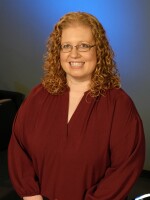Nathaniel Frissell put out a call and waited for a response.
“Hello, CQ, CQ, CQ, CQ, this is whiskey 3 uniform sierra romeo.”
An amateur radio operator from Virginia answered the call from the University of Scranton’s new amateur radio station — call sign W3USR.
Frissell, a University of Scranton associate professor of physics and engineering, and his students make connections around the world while conducting groundbreaking research about the earth’s upper atmosphere.
“Ham radio is a really exciting way to understand communications and many of the technologies that we interact with every day,” Frissell said.

With ham radio enthusiasts and researchers from across the country, the university dedicated the new radio station on Friday.
The group, along with students and community members, gathered at the station on Thursday night. Steve Cerwin, a physicist who traveled to the dedication from Texas, works with Frissell on the research. Cerwin called the facility a “world class amateur radio station.”
“Few of them are in this caliber, this high, this big antenna, this type of equipment,” Cerwin said. “These are things people dream about.”
The communications come through a 40-foot tower with a Skyhawk High Frequency antenna for 14, 21, and 28 MHz, as well as VHF/UHF satellite and microwave antennas, some with rotating mounts. The station also features heavy-duty controllers, all-mode transceivers, speakers, desktop microphones and other components.
From the fifth floor — the “penthouse” of the Loyola Science Center — floor-to-ceiling windows provide sweeping views of the campus and city. The voices of radio operators hundreds, even thousands of miles away, can be heard in the hallway.
The university’s W3USR Amateur Radio Club hosts club nights, open to the community, on Thursdays when classes are in session. The station is also used for physics courses and research by students and faculty participating with the Ham Radio Science Citizen Investigation (HamSCI) project led by Frissell.
The National Science Foundation recently awarded a $1.8 million collaborative grant to Frissell to provide sophisticated atmospheric measuring equipment to the nationwide network of ham radio enthusiasts and citizen scientists that he developed.
Frissell will serve as the lead principal investigator of the collaborative grant and will work with colleagues at Case Western Reserve University, the University of Alabama and the New Jersey Institute of Technology.
The enhanced capabilities to collect data on the earth’s ionosphere for this project builds on the HamSCI Personal Space Weather Station network of licensed amateur radio operators who have helped measure the effects of weather in the upper levels of earth’s atmosphere through a $1.3 million NSF funded project previously awarded to Frissell.
“We're trying to build a network of ground-based receivers that citizen scientists can use to study the effects of space weather on earth,” Frissell said.
When Northeast Pennsylvania could see the aurora borealis earlier this month, radio communication sounded fluttery and “hollow.” During April’s solar eclipse, Frissell and his students collected data on how the event impacted the earth’s ionosphere.
The ionosphere is located 50 to 400 miles above sea level and is home to all the charged particles in the earth's atmosphere. It is impacted by weather on earth and in space.
Amateur radio operators bounce radio signals off the ionosphere for communication. The strength of the bounce provides many clues about the ionosphere, such as its height, density and dynamics, according to NASA.
“We've already made some inroads to techniques for measuring the ionosphere from the bottom side that hasn't been done before, and we're getting new insights,” Cerwin said. “This is the only spectrum capable of worldwide communications without an appliance like a satellite or a cell phone infrastructure … It’s a natural resource that needs to be protected because if we get a severe solar event or something that brings down a great deal of the infrastructure, this communication is going to be what's left.”
At the weekly club night, Scouts Avery and Jordyn Flannigan made connections with operators elsewhere, including in Little Rock, Arkansas.
“Our QTH (location) is Scranton, Pennsylvania … back to you,” 12-year-old Jordyn said.
Gerard Piccini, an electrical engineering student from Monroe Twp., New Jersey, serves as club president. He welcomed visitors Thursday night.
“Pretty much everything we do nowadays, everything that's wireless, uses radio,” he explained. “Amateur radio is just a great way to understand how that works.”






